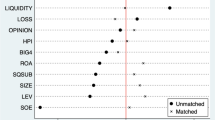Abstract
Thirty-four US states have already enacted some form of seller’s Property Condition Disclosure Law. At a time when there is a movement in this direction nationally, this paper attempts to ascertain the factors that lead states to adopt disclosure law. Motivation for the study stems from the fact that not all states have yet adopted the law, and states that have enacted the law have done so in different years. The analytical structure employs hazard models, using a unique set of economic and institutional attributes for a panel of 50 US States spanning 21 years, from 1984 to 2004. The proportional hazard analysis of law adoption reveals that greater number of disciplinary actions tends to favor passage of the law. Greater broker supervision, implying generally higher awareness among real estate agents, seems to have a negative impact on the likelihood of a state adopting a Property Condition Disclosure Law.

Please query online caption
Similar content being viewed by others
Notes
Article “What is a Seller’s Disclosure?,” October 1, 2001, by Dian Hymer, Distributed by Inman News Features.
Easton v. Strassburger (152 Cal.App.3d 90, 1984) was a California Appellate Court decision that expanded the duty of realtors and the grounds for realtor negligence in selling faulty homes. The State Supreme Court declined to hear the case, giving birth to the law in the state.
Not all states require real estate salesperson to carry Errors and Omissions insurance coverage.
Zumpano and Johnson (2003) conclude: “There seems to be little question that the property condition disclosure, whether mandatory or voluntary, can reduce error and omission claims against real estate licensees.”
See Lefcoe (2004) page 228.
This paper uses information through 2004. According to latest available information from the National Association of Realtors (http://www.realtor.org), 44 states and the District of Columbia have adopted seller property condition disclosure law. The only states that do not require any form of seller disclosure are Alabama, Arkansas, Kansas, Vermont, West Virginia, and Wyoming.
See Lefcoe (2004) pages 212–213.
See Lefcoe (2004) page 239.
See Kennedy (1998), pages 259–261 for a simple discussion on this structure.
See Wooldridge (2002), page 713 for a discussion.
Pancak et al. (1996) lists the states, which adopted the disclosure law until 1996.
When the disciplinary actions figure is missing or zero, we take the average of the figures within a 1-year range. When the total disciplinary actions figure is missing in ARELLO reports, if available, we take the sum of the figures under different categories of disciplinary actions, or we take the sum of the actions by consent and number of formal hearing as number of disciplinary actions (this is the case until 1986). Then we take sum of disciplinary actions and formal hearings from column of complaints resulting in some actions. Both of these are expected to provide the number of complaints having enough substance to attract legal attention. This is typically the case with Arizona and Hawaii for 1984–1986.
Pancak and Sirmans (2006) define the variable as a ratio of number of brokers and total number of licensees. Our definition (ratio of number of brokers and total number of salespersons) is directed more towards capturing “supervision” (of the salespersons) instead of “experience” (of the brokers).
Due to missing information, we cannot use all the years before the law adoption for Indiana, Montana, and New York. However, we still use information from pre-disclosure period for these states. For states without the disclosure law, we use average of all the available years.
Due to many small omitted influences on law adoption, normal distribution is expected to represent data better than gamma distribution.
See Zumpano and Johnson (2003), page 286.
References
Association of Real Estate Licensing Law Officials (ARELLO) Digest of Real Estate Licensing Laws and Current Issues (1985–2005).
de Figueiredo Jr., Rui J. P., & Vanden Bergh, R. G. (2004). The Political Economy of State-Level Administrative Procedure Acts. The Journal of Law and Economics Vol. XLVII.
Kennedy, P. (1998). A Guide to Econometrics. Fourth Edition. Cambridge, MA: MIT.
Kiefer, N. M. (1988). Economic duration data and hazard functions. Journal of Economic Literature, 26(2), 646–769.
Lefcoe, G. (2004). Property condition disclosure forms: how realtors eased the transition from ‘Caveat Emptor’ to ‘Seller Tell All’. Real Property, Probate and Trust Journal, Summer.
Moore, G. S., & Smolen, G. (2000). Real estate disclosure forms and information transfer. Real Estate Law Journal, 28, 319–326.
Nanda, A. (2005). Property condition disclosure law: Does ‘Seller Tell All’ matter in property values? University of Connecticut, Dept. of Economics Working Paper Series, No. 2005-47.
Olazabal, A. M. (2003). Redefining realtor relationships and responsibilities: The failure of state regulatory responses. Harvard Journal on Legislation, 40, 65–132.
Pancak, K. A., Miceli, T. J., & Sirmans, C. F. (1996). Residential disclosure laws: The further demise of Caveat Emptor. Real Estate Law Journal, 24, 291–332.
Pancak, K. A., & Sirmans, C. F. (2006). The effect of agency reform on real estate service quality. Journal of Housing Research, 15(1), 41–54.
Wooldridge, J. (2002). Econometric Analysis of Cross-Section and Panel Data. Cambridge, MA: MIT.
Zumpano, L. V., & Johnson, K. H. (2003). Real estate broker liability and property condition disclosure. Real Estate Law Journal, 31, 285–302.
Acknowledgements
This paper is adapted from my doctoral dissertation at the University of Connecticut, Storrs, CT. I would like to thank Stephen L. Ross, John M. Clapp, Dennis R. Heffley, Katherine Pancak, Sam Peltzman, and an anonymous reviewer for their insightful comments on the idea and methodology. The views and opinions offered in this paper do not necessarily reflect the position of the National Association of Home Builders (NAHB). All remaining errors are mine.
Author information
Authors and Affiliations
Corresponding author
Rights and permissions
About this article
Cite this article
Nanda, A. Property Condition Disclosure Law: Why Did States Mandate ‘Seller Tell All’?. J Real Estate Finance Econ 37, 131–146 (2008). https://doi.org/10.1007/s11146-007-9057-3
Published:
Issue Date:
DOI: https://doi.org/10.1007/s11146-007-9057-3



